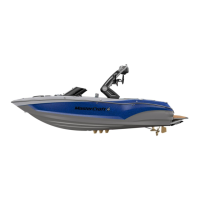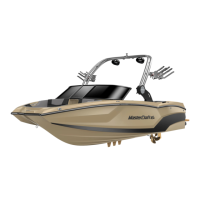2016 OWNERS MANUAL / 015
to do so can result in the accumulation of CO fumes.
• Never sit, teak surf, or hang on the back deck or swim platform
while the engine is running. Teak surfing is NEVER a safe activity.
• Never move into areas under swim platforms where exhaust out-
lets are located unless the area has been properly ventilated.
• Operation of boats at mile-high (5,250 ft.) or higher altitudes may
affect CO production. Check with an authorized MasterCraft deal-
er before operating at higher altitudes to determine whether the
engine may require additional tuning to prevent excessive CO.
• Although CO can be present without the smell of exhaust fumes,
if you smell exhaust fumes, CO is also present. Take immediate
action to dissipate these fumes.
• Treat symptoms of seasickness as possible CO poisoning. Get
the person(s) into fresh air immediately. Seek medical attention.
• Install and maintain CO alarms inside your boat. Do not ignore any
alarm. Replace alarms as recommended by the manufacturer.
• Follow Coast Guard safety checklists.
• Get a Vessel Safety Check. They are free! Your local U.S. Coast
Guard Auxiliary can provide details or check www.uscgaux.org
online to locate assistance.
HOW TO PROTECT YOURSELF
AND OTHERS
Following these simple steps to help keep CO from poisoning you,
your passengers and others nearby:
• Know where and how CO may accumulate in and around your
boat. This is particularly important when starting or running
engines in boathouses, or near a sea wall. Boats that are moored
in close proximity are also potential problems as the fumes from
your boat or another boat can affect air drafts on all boats. Back
drafting sometimes called the “station wagon effect” occurs
when the fumes curl up over the swim platform and transom and
into the boat, especially when canvas or other coverings can trap
the fumes. Even in open air, consider wind direction, the boat’s
speed and trim angles.
• Maintain fresh air circulation throughout the boat at all times. CO
concentration is greater when the engine is cold. Ensure the boat
is situated to take advantage of maximum dissipation of fumes.
• If your boat is equipped with a generator, know where the exhaust
outlet(s) is located and keep everyone away from the area.
• Ensure that appliance, air conditioning, heater, generator, or other
on-board function that emits fumes is routinely and regularly pro-
vided with maintenance as described by manufacturers. Failure
